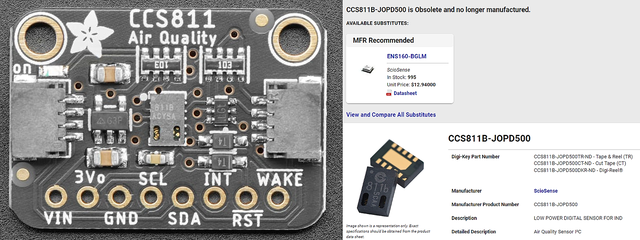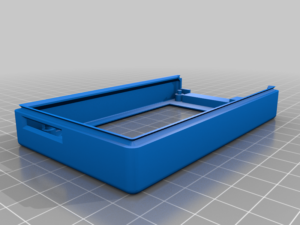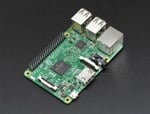[embedded content]
This week’s EYE ON NPI (video) is just in time for Earth Day – it’s a new environmental sensor: the ScioSense ENS160 Air Quality Sensor – a digital multi-gas sensor that offers optimum detection of volatile organic compounds (VOCs) and oxidizing gases.

This is a 4-in-one sensor that improves on common MOX gas sensors that have become popular on the market, but is still super easy to use.

This sensor is the successor to the popular CCS811, which we used for many years and was one of the first embedded MOX sensors on the market. It was quite popular but only had one MOX plate, and has been improved with the introduction of the ENS160.

Gas sensors are all essentially resistive sensors, where the exposed silicon has a metal oxide layer (MOX) that is susceptible to ambient gasses. There’s a heater element that you need to turn on, then wait until the silicon chunk can react with the air. The resistance changes with the amount of organic compounds in the air and you can measure the resistive differences.
Traditional gas sensors came with 4 pins: two for the heater, and two for the resistor. You have to power the heater, then use a resistor divider or op-amp to read the resistance and back calculate. There’s no built-in calibration available, you’ll have to figure out what each resistance ‘means’ in human-friendly terms like AQI or ppm/ppb concentrations. This made a lot of gas sensors difficult to use, and also unreliable without constant upkeep.

The new generation of MOX gas sensors follow in the footsteps of humidity sensors that were originally just capacitive sensors, but now are fully integrated with instant usable data. The CCS811 was one of the first to do this, a real pioneer. For these types of sensors, the MOX element is hidden inside, and the heater is automatically or digitally controlled.

Baseline readings are used to provide home or office-grade calibration where we may care more about changes in readings rather than absolute readings. For example, an office’s eCO2 reading has increased over the day from “good” to “poor” – that would indicate a need to turn on an HVAC fan or alert someone to open a window.

The ENS160 has 4 different sensor elements, each one will have slightly different MOX doping, which means it will react to different classes of gasses. Which is something to remember: it’s not like you can tell which TVOC you’re sensing – the whole family of ethanol, methane, acetone, etc. are all going to activate the sensing bodies. Likewise – if you need precision CO2 measurements, nothing beats an NDIR sensor. But those sensors are also pretty expensive – and don’t do TVOC sensing. For basic usage, eCO2 will work just as well and at significant power and cost savings. Likewise, if you need specific TVOC sensing, those will cost a lot more but they are tuned.

What we like about the sensor is that it’s fully integrated: no firmware blobs or NDAs required which means we were able to get it ported to Python without difficulty. There’s also an Arduino library published by ScioSense for integration in any C/C++ build. The library supports temperature and humidity compensation as well.

If you think the ScioSense ENS160 Air Quality Sensor is a breath of fresh air, then you’re in luck because they’re in stock right now at Digi-Key for immediate shipment!

You can also pick up some of the Adafruit-made breakouts for the ENS160 to get you started fast – our breakout includes regulators and level shifting, so you can drive it from 3 or 5V power and logic. Order today and you’ll have them in your hands by tomorrow afternoon.
See the ScioSense video:
[embedded content]
- SEO Powered Content & PR Distribution. Get Amplified Today.
- PlatoAiStream. Web3 Data Intelligence. Knowledge Amplified. Access Here.
- Minting the Future w Adryenn Ashley. Access Here.
- Source: https://blog.adafruit.com/2023/04/27/eye-on-npi-sciosense-ens160-air-quality-sensor-eyeonnpi-digikey-sciosense-digikey-adafruit/
- :has
- :is
- :not
- :where
- $UP
- 500
- a
- Able
- About
- Absolute
- AIR
- Alert
- All
- also
- Ambient
- amount
- an
- and
- any
- Arduino
- ARE
- AS
- At
- automatically
- available
- back
- basic
- because
- become
- been
- breakout
- breakouts
- Breath
- build
- built-in
- but
- by
- calculate
- CAN
- care
- Changes
- classes
- co2
- Common
- Compensation
- constant
- content
- controlled
- Cost
- cost savings
- data
- day
- Detection
- differences
- different
- digital
- digitally
- do
- Dont
- drive
- each
- earth
- Earth Day
- easy
- element
- elements
- embedded
- environmental
- essentially
- etc
- example
- expensive
- exposed
- eye
- family
- fan
- FAST
- Figure
- First
- follow
- For
- fresh
- from
- fully
- GAS
- generation
- get
- going
- had
- Hands
- Have
- Hidden
- Home
- HTTPS
- hvac
- if
- immediate
- improved
- improves
- in
- includes
- increased
- indicate
- instant
- integrated
- integration
- Introduction
- IT
- jpg
- just
- layer
- Level
- Library
- like
- Lot
- luck
- made
- many
- Market
- max-width
- May..
- means
- measure
- measurements
- metal
- methane
- more
- Need
- New
- no
- nothing
- now
- of
- Offers
- on
- ONE
- only
- open
- optimum
- or
- order
- organic
- originally
- our
- out
- over
- overview
- pick
- pins
- pioneer
- plato
- Plato Data Intelligence
- PlatoData
- Popular
- power
- Precision
- pretty
- provide
- published
- Python
- quality
- rather
- React
- Read
- Reading
- real
- Regulators
- remember
- required
- Resistance
- Savings
- sensors
- SHIFTING
- significant
- Silicon
- slightly different
- So
- some
- Someone
- something
- specific
- started
- Still
- stock
- Super
- Supports
- susceptible
- tell
- terms
- than
- that
- The
- Them
- then
- These
- they
- think
- this
- those
- time
- to
- today
- tomorrow
- TURN
- two
- types
- usable
- Usage
- use
- used
- volatile
- wait
- was
- we
- WELL
- were
- What
- which
- Wikipedia
- will
- with
- without
- Work
- would
- years
- you
- Your
- youtube
- zephyrnet












